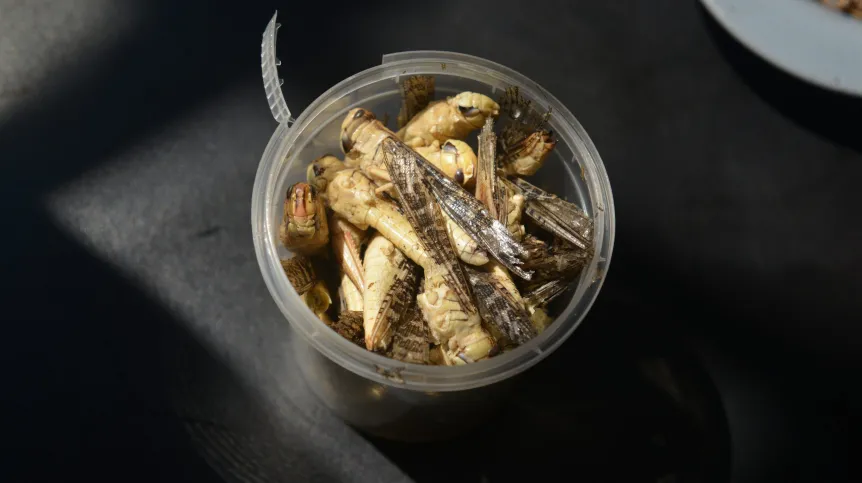
Before eating insects becomes our everyday reality, scientists need to know whether ants, mealworms, locusts and cockroaches are a good food source. They have to investigate what nutrients they contain, how these nutrients are absorbed by our bodies and which beetles are most caloric. Such research is being conducted by Dr. Anna Żołnierczyk from Wrocław University of Environmental and Life Sciences.
The researcher spoke about the taste of the insects she tested in an interview with PAP. "Insects are usually roasted or fried, also those served as sweets, in chocolate. For example, we made superworm brownies. Ants have acidic aftertaste and are compared to citrus fruits. Larvae such as mealworms contain a lot of fat, so they have a nutty flavour, just like cold pressed rapeseed oil. Crickets, if eaten in their entirety, resemble well-fried meat. Locusts are best in bread crumbs. Silkworms are a rich source of micronutrients" - said the researcher. And cockroaches are the future of Wrocław culture. There has not been an official tasting yet, but researchers predict that cockroaches, like shrimps, will be extracted from chitin armour and consumed warm.
Dr. Żołnierczyk is the supervisor of the Student Molecular Cuisine Sciece Club. Previously, she and her students participated in Food Think Tank educational projects. The project also has the support of the consortium Wrocław Biotechnology Centre formed by eight entities, including three faculties of the Wrocław University of Environmental and Life Sciences. The consortium has been awarded the status of the National Leading Research Centres (KNOW) in the field of agricultural sciences.
"At first we bought larvae of beetles - mealworms, superworms, and two locust species: desert and migratory locust. We are a faculty of food science, so are primary interest is whether insects have adequate nutritional value. Insects are considered a low calorie protein source. If we compare beef steak and cricket steak, the former, containing a lot of fat, tastes much better. In contrast, insect +meat+ contains much more protein in relation to fat, especially in adult insects. Consequently, it can be considered a low calorie or dietetic source. We conduct research on the calorific value of insects and protein content in the food prepared from them" - explained Dr. Żołnierczyk.
To obtain a complete nutrition information, scientists began research from the fatty acid profile. Vegetable fat is better than animal fat, but it\'s important that these are unsaturated fatty acids. Equally important in our diet are sterols - not just cholesterol, but also phytosterols. So they studies the profile of sterols and elemental composition of insects - calcium, iron, magnesium, sodium, potassium, as well as heavy metals.
Research also concerns the bioavailability of metals. Dr. Żołnierczyk explained that some metals are better absorbed if they come from animal products, compared to those from plants. For example, iron is better absorbed from animal products as heme iron.
"Insects are consumed in 80 percent countries in the world - either as an add on, or as a permanent part of the diet. Western civilization, especially Europe, opposes this custom. We associate insects with dirt, we do not even want to imagine them in out mouths, we feel disgust. Still, we eat shrimps that have come to our tables and are a delicacy. If you look at a shrimp and a cockroach, there is not much difference between them" - said the researcher.
And what about the fact that insects are considered to be dirty? According to Dr. Żołnierczyk, they are no dirtier than other products we eat. Yes, insects also often have parasites, bacteria, but after all, insects for consumption are not caught in the meadow. It is important to breed them under controlled conditions to avoid microbial infections. Before serving insects, they should always be subjected to thermal treatment.
"We all receive toxins from the environment. If we want to breed beef, we must have a large field, a pasture, appropriate premises. Insects are easy to breed, in this case all you need are sterile boxes on shelves in an average room. The culture can be maintained under appropriate conditions, with no harmful environmental compounds, such as heavy metals or contaminated water" - said the researcher.
She added that control is easy, and large amounts of biomass are quickly obtained. There is even home insect-breeding equipment, in which leftovers from the table and from the kitchen are placed. It is similar to sprout growing devices. This is how it is done in Asian countries where insect protein is a valued culinary additive.
Researchers have already examined two types of beetle and locust larvae, and now they are investigating cockroaches. They also try to create functional foods. This involves feeding the insects in such a way that they have more nutrients and biologically active compounds in their bodies. Some biologically active compounds should be included in our diet, but they are poorly absorbed. Everything can change if these valuable ingredients are pre-processed by insects. Perhaps insects, as a result of their metabolism, can transform them into compounds that will be soluble in water without losing their properties. Then, if we ate such an insect, we would also receive an easily absorbed compound.
Dr Żołnierczyk emphasised the economic value of insect cuisine. Insects are a cheap source of food. With the same amount of feed, you can grow about 9 times more crickets than beef. She reminded that cows are warm-blooded and need a lot of energy from food to maintain their vital processes and body temperature. Insects convert most of what they eat into biomass.
"Insects have more edible parts, and some of them can be eaten whole. With cows, we throw away as much as 60 percent: skin, bones, hooves, horns. In the case of all insects, waste is only 20 percent on average" - said the researcher.
Another aspect is environmental protection. Insect breeding means much lower water consumption than breeding other animals that supply us with protein. With the same amount of water, you can grow 12 times more insect mass than beef mass. Beef transport and breeding are associated with greenhouse gas emissions, ammonia pollution, acid rain and environmental degradation.
"All novelties are approached with a lot of uncertainty. When sushi came to our market, we felt resistance against eating raw fish. Today it is an luxury dish. Maybe in a few, several years, we will have to eat insect protein. Before that happens, we should properly test it" - concluded Dr. Żołnierczyk and reminded that we eat worms anyway. This happens in our sleep, when we are running or riding on a bike. We eat them without being aware of it in fruit and vegetable products, and when we eat cherries, plums, apples and pears. We consume a lot of worms in dried mushrooms. We statistically eat about half a kilogram of insects per year.
PAP - Science and Scholarship in Poland, Karolina Duszczyk
kol/ agt/ kap/
tr. RL













